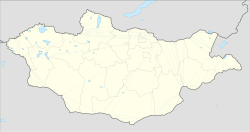Shankh Monastery
| Shankh Monastery Шанх хийд | |
|---|---|
| Religion | |
| Affiliation | Tibetan Buddhism |
| Location | |
| Location | Övörkhangai Province, Mongolia |
| Country | Mongolia |
| Geographic coordinates | 47°03′05″N 102°57′14″E / 47.0514°N 102.954°E |
| Architecture | |
| Style | Chinese, Mongol and Tibetan influences |
| Date established | 1647 |
Shankh Monastery (
The monastery belongs to the
The meaning of the word shankh is unclear, with some speculating it refers to the small mountain range between the monastery and Erdene Zuu Monastery, while others claim it refers to “a group of objects arranged in a particular order”.[1]
History
Zanabazar founded Shankh Monastery in 1647 when he was just 12 years old. For many years it was known as the “Monastery of the West” (Baruun Khüree). It began as a ger monastery, and moved several times before settling in its current location in 1787 and taking on its current name.[2] Nevertheless, a large number of monks continued to maintain the traveling camp until the late 19th century.
According to the Russian ethnographer Aleksei M. Pozdneev, who visited the monastery in 1892, in addition to the main temple, built between 1710 and 1790, it consisted of five large beautifully decorated gers that could accommodate nearly 200 people.
At its height the monastery included several schools that practiced Tantric rituals, especially
Like most of Mongolia's religious centers, Shankh Monastery was closed down in 1937 and most of its standing structures destroyed by the country's communist regime as part of violent Stalinist purges. Many of its monks were executed or sent to labor camps in Siberia while 5 young novices were permitted to return to their families.[6] The main temple, which had escaped major damage, was later used as a warehouse. Fortunately, most of the monastery's precious relics were removed and hidden away by one of the young novices, Gombo, and thus survived the destruction of the monastery.[7]
Restoration
After the
Notes
- ^ "Shankh Monastery". Archived from the original on 16 August 2006. Retrieved 13 March 2013.
- ^ "Shankh Monastery". Archived from the original on 16 August 2006. Retrieved 13 March 2013.
- ^ "Shankh Monastery". Archived from the original on 16 August 2006. Retrieved 13 March 2013.
- ISBN 1841624160.
- ISBN 978-3-89794-167-0, S. 196.
- ISBN 978-1-74104-578-9, S. 119.
- ^ "SHANKH MONASTERY". Retrieved 13 March 2013.

